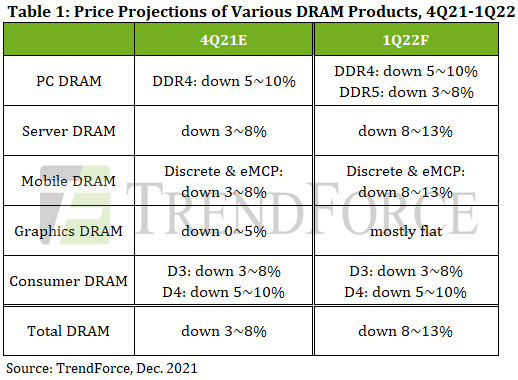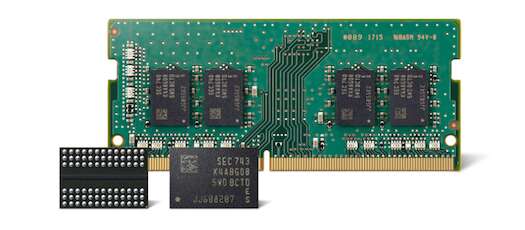-
Here
- Home >> News >> Company News
Here
Buyers will find some pricing relief early next year as DRAM ASPs are expected to decline by as much as 8- to -13 percent, according to TrendForce. Gating materials and components are pushing DRAMs into oversupply in Q4, reports distributor Fusion Worldwide. As a result, year-end audits and inventory issues may cause buyers to hold off purchasing or restocking DRAM.
Among electronic components, DRAM is known for volatility in supply and pricing. In March, TrendForce reported DRAM prices increased by 18 percent. DRAM is a commodity so ASPs fluctuate widely based on supply and demand.
Fusion predicts Q4 is the first quarter where official prices will drop; sources indicate the price drop and lower demand will further expand the decline in other ranges of memory products.
 Regarding end products in 4Q21, TrendForce expects the quarterly shipment of notebook computers to remain about the same as 3Q21 as prior component gaps were partially resolved during the quarter. As such, PC OEMs’ DRAM inventory has been lowered by several weeks.
Regarding end products in 4Q21, TrendForce expects the quarterly shipment of notebook computers to remain about the same as 3Q21 as prior component gaps were partially resolved during the quarter. As such, PC OEMs’ DRAM inventory has been lowered by several weeks.
Even so, the overall demand for DRAM will enter a cyclical downturn in 1Q22, during which DRAM ASPs will maintain a downward trajectory with an 8-13 percent QoQ decline. Whether this price drop will subside going forward will depend on how well suppliers manage their inventory pressure and how DRAM purchasers anticipate further price changes.
Decline will narrow somewhat
Whereas demand for Chromebooks has noticeably slowed down, demand for consumer and commercial notebooks remains strong, TrendForce reports. Certain components which were previously in shortage are starting to experience improved lead times. Hence, quarterly shipments of notebook computers for 4Q21 will likely surpass earlier projections.
Looking to 1Q22, not only will demand undergo a cyclical downturn but the sufficiency ratio of PC DRAM will surpass 3.0 percent following 4Q21’s high base period for comparison. These factors will result in DRAM prices undergoing a noticeable decline, although PC OEMs will carry a lower inventory of DRAM in 1Q22 compared with 11-13 weeks of inventory in the previous quarter.
On the other hand, as mobile DRAM prices begin to drop, certain DRAM suppliers have begun reallocating some of their production from mobile DRAM to PC DRAM. As a result, PC DRAM bit supply will likely undergo a corresponding increase in the short run.
Although these factors provide some upside momentum that narrows the price drop of PC DRAM products, they are not enough to result in an upturn, according to TrendForce. In particular, DDR4 and DDR5 PC DRAM will experience QoQ declines of 5-10 percent and 3-8 percent, respectively, for 1Q22, although the latter product will not noticeably impact the overall PC DRAM ASP as its penetration rate is still relatively low.
Memory modules remain on downtrend
Fusion reports pricing for memory modules continues to be on the downtrend following the 3-5 percent dip in pricing in November across all densities. Vendors are currently sitting on high amounts of inventory of 32GB / 64GB RDIMM and SODIMM parts with speculation the downtrend will continue into Q1 2022. To avoid unpredictable losses due to the current volatility of the semiconductor supply chain, vendors are purchasing on back-to-back orders rather than going to the market to buffer additional stock.
Slowdown in procurement activities
TrendForce reports CSPs and enterprise clients are carrying about 6-9 weeks and 8-10 weeks of server DRAM inventory, respectively. Although these levels represent a slight decline compared to the end of 3Q21, this decline will not substantially contribute to an increase in demand. Hence, server DRAM buyers will remain relatively conservative regarding procurement activities before server DRAM prices reach a level that these buyers consider to be rock bottom.
DRAM suppliers’ inventory of server DRAM, on the other hand, has been gradually rising since 1H21 owing to decreased demand, TrendForce reports. Certain suppliers have also ramped up their wafer input for server DRAM products. While both buyers and sellers have reached a consensus on the falling prices of server DRAM, supply chain-related component gaps have gradually resolved, meaning Tier 1 clients will lessen their server DRAM procurement in the upcoming off-season. As a result, suppliers will then be able to fulfill orders that were placed by Tier 2 clients but previously deferred because suppliers prioritized orders from Tier 1 clients. These Tier 2 client orders will provide some upside demand for server DRAM, which is a component that is in relative surplus compared to other components. Server DRAM prices are forecast to decrease by 8-13 percent QoQ in 1Q22, during which server DRAM prices will experience the most severe declines compared to the other quarters in 2022.
Mobile DRAM prices will decline
Thanks to mobile DRAM suppliers’ aggressive sell-offs in 4Q21, smartphone brands still carry a high level of mobile DRAM inventory at year-end, according to TrendForce. Looking ahead to 1Q22, not only will the market welcome the arrival of the traditional off-season, but other issues with the supply of processor chip bundles and the impact of the Covid-19 pandemic will result in a 10 percent QoQ drop in smartphone production.
Smartphone brands will be even more conservative in procurement to avoid inventory buildup. As brands revise production targets downward, demand for mobile DRAM has weakened from 1H21, exacerbating the oversupply situation.
On the whole, high inventory levels and oversupply will lead smartphone brands to further constrain their production and procurement plans in 1Q22. Given that suppliers have suggested a sales strategy of negotiating for 4Q21 and 1Q22 prices collectively, and both buying and selling sides are confronted with inventory pressure, TrendForce forecasts an 8-13 percent QoQ decline in mobile DRAM prices for 1Q22.
Graphics DRAM prices will hold flat
The application demand for graphics DRAM has been recovering noticeably in the recent period. Even so, TrendForce points out that the graphics DRAM market is subject to a very high degree of fluctuations, and this situation is exacerbated by the introduction of the application demand from cryptocurrency mining in recent years. Because the values of cryptocurrencies can swing dramatically, GPU manufacturers such as NVIDIA and AMD have to constantly adjust their sales strategies and switch between bundling and de-bundling. In so doing, they are contributing to the rapid rise and fall of graphics DRAM demand.
The graphics DRAM products that the three dominant suppliers are now producing belong to the GDDR6 series. The latest distribution of graphics DRAM output by chip type shows that suppliers are also gradually shifting their focus from 8Gb to 16Gb. Micron, in particular, is the most proactive in this transition and will EOL a series of parts. On the other hand, the mainstream graphics cards are still using 8Gb chips so the demand for 8Gb graphics DRAM has increased.
 Spot prices of both GDDR5 8Gb and GDDR6 8Gb chips have increased significantly, according to TrendForce. The difference between spot and contract prices is now negligible for graphics DRAM. Some spot transactions even reveal prices that are higher than contract prices. This latest development reflects a situation where buyers are more proactive in price negotiations.
Spot prices of both GDDR5 8Gb and GDDR6 8Gb chips have increased significantly, according to TrendForce. The difference between spot and contract prices is now negligible for graphics DRAM. Some spot transactions even reveal prices that are higher than contract prices. This latest development reflects a situation where buyers are more proactive in price negotiations.
Prices of graphics DRAM products on the whole will be fairly flat due to the rise in spot prices.
DDR3 Consumer DRAM prices will drop
TrendForce forecasts demand for consumer (specialty) DRAM will be relatively weak in 1Q22 due to consumer electronics’ seasonality. Also, demand will stay fairly depressed for TVs, which represent the leading source of in-home entertainment spending. This is because countries around the world will continue in their attempts to lift their pandemic-related restrictions.
In addition to these factors, component gaps in the supply chain will still be a serious challenge for device manufacturers. As DRAM components are in excess relative to non-memory components, device manufacturers will be less willing to stock up on the former.
Suppliers have been slow to scale back production for DDR3 products this year because prices surged during the first half of the year. However, the downward pressure on prices has now become much more significant, so the two leading South Korean suppliers have taken the initiative to revise their product mix strategies, said TrendForce. Hence, they will again transfer more of their mature wafer processing capacity from DDR3 products to CMOS image sensors or logic ICs.
TrendForce points to the strong correlation between DDR4 consumer DRAM products and PC DRAM products. The latter were the first to experience a weakening of demand, and their prices have already made a downward turn in 4Q21. Looking ahead to 1Q22, contract prices of PC DRAM products will keep falling because of their significant difference with spot prices. This means that DDR4 consumer DRAM products will also suffer sliding prices for 1Q22 with QoQ declines reaching 5-10 percent.
Looking at DDR3 consumer DRAM products, prices will drop as supply is shrinking. Contract prices of DDR3 2Gb chips are projected fall by 3-8 percent QoQ on average for 1Q22, whereas DDR3 4Gb chips are projected to register larger declines.